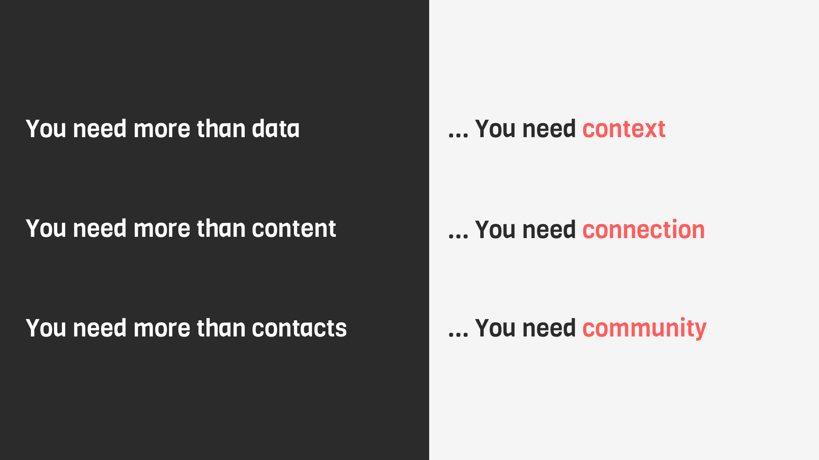“Crisis of disconnection.” These were the words of HubSpot's CEO, Yamini Rangan, when she launced INBOUND22. And precisely 'Connection' was to become the main focus of this year's HubSpot event.
Every year HubSpot invites users and partners to INBOUND which is an event held physically at the platform's headquarters, Boston, with the option of online participation. The purpose of the event is to share knowledge about the platform's many possibilities - and then veil is lifted for new developments.
This year the stage was set with the words of Yamini Rangan. And it was very appropriate that the event was initiated by the CEO of the platform. Not only were these inspiring and extremely topical words from Yamini Rangan they also became the common thread for the entire event. And she managed to land well.
The focal point for INBOUND22 was connection and the lack thereof. Lack of connection between systems. Lack of connection between people. And lack of connection between seller and buyer.
And it was an extremely topical focal point. Because when we lose the connection a gap appears which puts an end to our growth - both for people and businesses. INBOUND22 highlighted in particular how an abundance of channels and content as well as COVID19 has meant that today we are 'disconnected' like never before. Therefore, HubSpot's most important agenda for INBOUND22 was that we establish connections again.
Digital fatigue and the need for communities
INBOUND22 highlighted three ways the lack of connection affects us to a greater or lesser degree.
- Companies struggle with many systems that do not talk to each other.

A survey among companies shows that the biggest challenge at the moment is that their systems and data are not connected.
The average company uses 242 apps to manage and organize the business. As such it is not the high number of tools in the form of apps that is the problem. The problem is that they are not connected. Data does not talk to each other in organization and the departments and internal communication suffer from this which are also disconnected. Studies show that it results in 47 % fewer interactions at work. And that is a problem.
Efficiency and quality decrease because we have to spend time collection and coordination data. And there is always a risk of data and information being lost between two chairs.
It also means that we lose the feeling of the good user experience. It is the collaboration between departments and data that forms the basis for us to be able to create good user experiences at all.
The sales department has important information about the customers' wishes and needs which the marketing department should make use of in marketing. And data on everything from sales and leads to customers and pipeline is essential for you to keep creating the good experiences.
Therefore, it is about looking inside the organization and find where to optimize and re-estabilsh connections internally. In this way, you make time more efficient and get the best foundation for creating good customer experiences.
- People are disconnected to each other

When COVID-19 was at its peak most people found solace in a new hobby, community, or home projects. And we did that because we needed something to do. But we also did it because we needed to feel connected to something when we could no longer find the connection and community at work or for leisure activities. Many therefore sought community in various groups with walk-and-talk outside, online training, or forums on social media.And it is very natural for people to seek communities. We learn best together with others. We are inspired and get new ideas from others. Humans need the feeling of community - both in good and bad times. The urge to feel connected to others is deep within all of us.
Therefore, there is great potential out there waiting. It is about creating communities and experiences that your customers can seek refuge in when they need it most.
- Companies and customers are disconnected

Last, but certainly not least: Companies have lost touch with customers. And one of the biggest reasons is digital fatigue.
We are overexposed with content in the media image. Just look on Facebook. The site which was once a platform with a network of acquaintances is today a large sales channel filled with advertising and sponsored content. Once we loved browsing through the social media feed now it is all turned into advertising. Once we loved reading our emails now they all go straight to spam. In fact, studies show that 65 % of all Google searches end without a click. And there are 40 % fewer who respond to sales emails.
All of this is an expression of the fact that we are digitally drained, and therefore it is difficult for companies to connect with the customer. The channels that companies have depended on to meet and connect with customers are not working as they used to.
Therefore, there is need for rethinking how and where companies meet their customers.
What do We do to Reconnect?
We need to find a way to connect back to growth. But how exactly we do it is difficult to answer. The lack of connection in various guises is a challenge we all face, and the solution is therefore not just at our feet.
Nevertheless, INBOUND22 made an attempt to find the solution. With many exciting presentations, various suggestions were made on how we can reconnect internally within the company, between people and between seller and buyer. Here we have collected a selection of them.
Make friends with (the hard) social media algorithms
We are faced with an abundance of content on social media, and it has only become more difficult to sift through the crowd. Nevertheless, social media is still important because it is mainly where we connect to each other.
The algorithm has the power and determines visibility on social media. That is why it is a good idea to get to know the algorithms better so you give yourself the best conditions to break through the noise to the right people.
For example, the algorithm on LinkedIn tells you that it is crucial that your post receives comments within the first 4 hours of its lifetime. And on Facebook it is long content and long videos that the algorithm prioritises. In fact, a study shows that a video over 5 minutes on average generates 268 % more engagement than short content. Meanwhile, the algorithm on Instagram prefers that you produce live content at least twice a week.
Surprised? We understand that very well. Algorithms change at lightning speed, and therefore what worked last month may already be outdated. When it comes to reconnection with your potential customers social media is still an important tool. Therefore, it is a good investment to keep up to date on the power of algorithms so that you do not grope blindly but actually succeed and are visible in the market.
Once you get to know the algorithms better you can start using them as tools to reach your target audience and spread the word about the unique community you have to offer.
Reconnect and focus with the 95/5 Rule
Where are your customers? It is a question you need to answer in order to reconnect with customers. With the distribution of customers at 95/5 as a rule of thumb you get a better understanding of the customers' wishes and needs.
The 95/5 rule says that it is actually only 5 % of your customers who are on the market and ready to take an action in the form of e.g. a purchase, call, or meeting booking. Meanwhile the remaining 95 % of your customers are not actively on the market at all.
This does not mean that the 95 % are less important than the 5 %. Quite opposite. It is important to create brand awareness for these in particular so that they know exactly who to approach as soon as they enter the market.
Therefore, there is no point in your communication exclusively addressing target groups that are already far along the buying journey. You are doing yourself a favor by already involving and taking into account the many potential customers who are out there in the future.
So what should you do? Think of it as two groups next to each other - those on the market and those who are not - which together secure you and your business in the future. Target the communication and take account that all customers are not at the same place in the buying journey.
Let them feel that they are part of a community - even those who are not necessarily ready to take action. But let them know that there is a unique community waiting for them.
In this way, you maintain the connection with the 5 % of customers on the market, and you form the foundation for the connection with 95 % of potential customers in the future.
Email marketing that does not end up in spam
Are emails still working? We started the blog post by pointing out that many people are tired of sales emails which often end up in spam. However, we now highlight email as an important channel to reconnect. And we do that because email is still the best tool to achieve a high ROI. If it is used correctly.
On social media and Google you have to pay to join but with emails you do not have to find your wallet. And of course there is still a big advantage in that.
But to be successful with your emails it is important that they are not just ordinary sales emails where it is clear that all you want to do is sell a product or service.
Instead emails should also be used to let recipients feel that they are part of an exclusive community. You can do this for example with a welcome flow for new subscribers with offers or good advice that are so extraordinary and unique that you can not resist opening the email.
It is not entirely unimportant whether new subscribers open and read the first email. If a new customer opens the first email from you the probability that you will be in their inbox in the future is increased by 95 %. And there is a 22% % probability that the same subscriber will become a customer.
Emails still work as long as you use them carefully and correctly. Otherwise, you will also end up in the big pile of emails in the spam inbox.
INBOUND22 manifested that we are particularly in a 'Crisis of disconnection'. And how we get out of the crisis can be difficult to answer. However one thing i certain: Now is when we most need to be part of communities and feel connected to something or someone. And knowledge of the algorithms, focus on the buyer on and off the market, and the right emails can be your means to reconnect!
Do you Need Advice in HubSpot?
MCB is HubSpot Platinum Partner and specialists in everything that moves within the platform.









